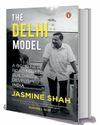
The chambers of our Parliament building have hosted and witnessed nearly a century of proceedings that have shaped and moulded the destiny of our great nation.
Legislation and deliberation, all were given life in the beating heart of these great halls. The building itself symbolically metamorphosed from the seat of colonial power to the temple of democracy. It was here that the nation heralded the end of imperialism and announced the tryst with destiny’:
The corridors of the building are living testimony to the freedom struggle led by the Indian National Congress and the loud revolutionary announcement made by Shaheed Bhagat Singh and his comrades. When I walked through these corridors as a young visitor, I had goosebumps as I imagined stalwarts like Jawaharlal Nehru, Dr B.R. Ambedkar, Babu Rajendra Prasad and others who wrote the destiny of India in the Central Hall while framing our Constitution.
I was an ordinary Indian who had experienced the double jeopardy of colonial rule from Delhi and also the undemocratic totalitarianism of the Nizam. Also, Ihad lived through the discrimination institutionalised in Indian society for ages. So, for me, our Parliament held a special meaning. It promised me an India with equality and human values. Its proceedings held out a dream that would bring in reforms and change the lives of millions of Indians.
As a child, I was always politically inclined. Gulbarga, where I grew up, was a confluence of political activities because of its geographical location. Leaders like Ram Manohar Lohia, S.A. Dange and others on their way to Mumbai, Bengaluru or Hyderabad would stop over, hold public meetings and change trains to proceed. I picked up my political thought and philosophy from their speeches and interactions. They gave me infallible faith in Indian democracy and its immense possibilities.
Esta historia es de la edición January 01, 2023 de THE WEEK India.
Comience su prueba gratuita de Magzter GOLD de 7 días para acceder a miles de historias premium seleccionadas y a más de 9,000 revistas y periódicos.
Ya eres suscriptor ? Conectar
Esta historia es de la edición January 01, 2023 de THE WEEK India.
Comience su prueba gratuita de Magzter GOLD de 7 días para acceder a miles de historias premium seleccionadas y a más de 9,000 revistas y periódicos.
Ya eres suscriptor? Conectar

Forging the future
As the curtain falls on 2024, I take pride in the extraordinary milestones achieved under the leadership of Prime Minister Narendra Modi. This year stands as a testament to the Modi government's resolve to forge a resilient and forward-looking Bharat. From groundbreaking advancements in infrastructure to visionary global initiatives, these efforts resonate deeply with the vision of Viksit Bharat.

Our strange democracy
Abraham Lincoln is lauded as among the very best presidents the US ever had: the statesman par excellence successfully steered the nation through the devastating and perilous years of the American civil war. Not only did Lincoln manage to keep his country united, he also ensured the passage of the 13th amendment to the US constitution, which abolished slavery.

Five years of post-pandemic fashion
It has been five years since we discovered what Covid-19 was, and five years since it disrupted the world forever. The World Health Organization activated their emergency systems on January 1, 2020, and informed the world by January 4, 2020. By the end of that week, they had set guidelines for various countries to follow. Comparable to the Spanish flu of 1918, more than 7 million people have died of Covid according to official data. Unofficially, no one has an idea. WHO has just this week asked China to provide critical data to understand the virus's origins as a “moral and scientific imperative”.

Community spirit
Rhythm of Dammam opens a window to the world of African-origin Siddis of Uttara Kannada

'Breaking' down a scandal
Society Girl is not just a case study of a high-profile death in Pakistan but also a stark commentary on media trials

Progress card
Jasmine Shah's book tells you what the AAP has achieved in Delhi in the last 10 years

SENSE IN NONSENSE
In his latest book of poetry, Ruskin Bond is at his funniest

Get ready for Trump bump
The ‘butterfly effect’ is a beautiful, mysterious metaphor of the planet’s interconnectedness.

QUIET FLOWS THE FAITH
The melding of an ancient amorphous faith and the latest science; of an antique tradition and new practices; ways of life older than memory and new expressions is happening at Prayagraj in Uttar Pradesh.

Trash to treasure
How a weed-choked Dal Lake spurred Maninder Singh's journey to become a waste management visionary